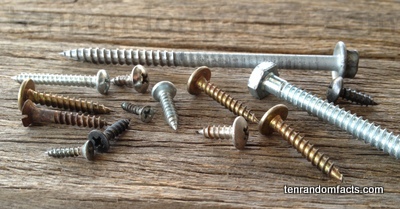These facts are screwed in.
- A screw is generally a small tapered rod, with a thread, that is used to attach two or more items to each other, and it typically has a sharp pointed end to puncture the material it is being threaded into.
- ‘Screws’ are sometimes called ‘bolts’, although this term is somewhat inaccurate, as bolts usually require a nut, while the former, do not.
- Screws have a flat or raised top, called a ‘head’, to prevent deep embedding and in some instances, to provide a decorative finish.
- A screw is commonly used with a screwdriver or wrench to rotate it, so that it threads into the material, as well as to tighten it.
- Screws typically are designed to fasten clockwise and have, what is called ‘a right handed thread’, although anticlockwise (left) fastening ones are available.
- Screws were most likely invented before 300 BC, possibly by the legendary Archimedes, a Greek polymath, and early forms were generally made of wood and were often used as part of a press for wine or oil.
- Screws are most commonly made of strong metal, typically steel, although noncorrosive materials are sometimes needed, so stainless steel, brass, and in some circumstances, plastic, is used.
- Metal screws have only been popularly used since the late 1700s, and they were patented multiple times in the second half of the 1800s.
- Screws can be used instead of nails, pins, rivets, glue, tape, welding and soldering.
- Screws most commonly have a signal straight slot in the head, for a screwdriver, although the cross shaped slot in a Phillips head is also popular, and there are many other designs available, including square, hexagon and star shaped slots.
Bibliography:
The History of the Screw, n.d, Wagner, http://www.wagner-werkzeug.de/fileadmin/pdf/Geschichte-Schraube-ENG.pdf
Screw, 2014, Wikipedia, http://en.wikipedia.org/wiki/Screw







really good site